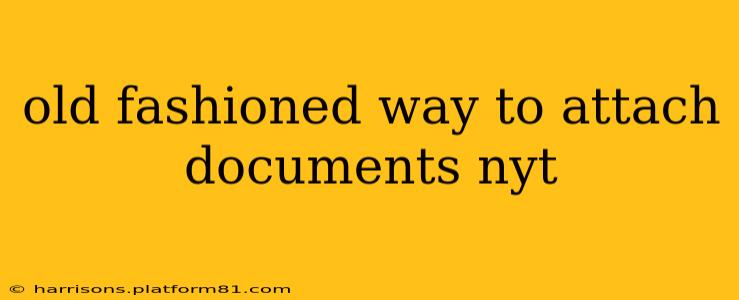The digital age has revolutionized how we share documents, making the process nearly instantaneous. But before email, cloud storage, and even fax machines, people relied on a variety of methods to attach documents, each with its own quirks and limitations. This article explores these "old-fashioned" ways, offering a glimpse into the past and appreciating the evolution of document transmission.
What are some old methods for attaching documents?
This question encompasses a range of techniques, depending on the urgency and distance involved. The methods varied widely in speed and convenience.
1. Postal Mail: This was, and still is, the most common method for physically sending documents. Documents were placed in envelopes, often with registered mail or certified mail options for tracking and proof of delivery. This method, while reliable, was slow, especially for longer distances. The speed depended on the postal service's efficiency and geographic location. Bulk mailing was common for sending large quantities of the same document.
2. Courier Services: For faster delivery, especially for time-sensitive documents like legal briefs or important contracts, courier services were employed. A courier would physically transport the documents, providing a much faster turnaround than postal mail. However, this was significantly more expensive.
3. Fax Machines: The fax machine, a staple in offices for decades, offered a relatively quick way to transmit documents electronically. While not technically "attaching" in the digital sense, it created a paper copy at the receiving end. Faxes were susceptible to poor quality, especially with complex graphics or multiple pages, and required a dedicated machine at both sending and receiving locations. It's important to note that faxing is becoming less common due to security and efficiency concerns.
4. Physical Delivery: For extremely urgent or sensitive matters, a person would physically deliver the documents. This is often employed within a city for very important legal or financial documents that require absolute certainty of delivery.
What was the most common way to attach documents before email?
Before email, the most common way to attach documents depended largely on the context and urgency. For most non-urgent situations, postal mail was the standard. For urgent documents, courier services and fax machines were increasingly popular, especially in business settings. The choice often involved balancing speed, cost, and reliability.
What are some disadvantages of the old ways of attaching documents?
The "old-fashioned" ways of attaching documents had several significant drawbacks:
- Speed: Postal mail was extremely slow, and even courier services were considerably slower than modern digital methods.
- Cost: Courier services and registered mail were significantly more expensive than email.
- Security: Documents were physically vulnerable to loss or damage during transit.
- Accessibility: Fax machines required specific equipment and were not accessible to everyone.
- Storage: Maintaining physical copies requires significant storage space and organization.
What is the most efficient way to attach documents now?
In today's world, email remains one of the most efficient and common ways to send documents, particularly with the widespread adoption of cloud-based file-sharing services that allow for the easy and secure transmission of documents of all sizes. These methods offer speed, convenience, and reduced costs compared to their historical counterparts.
The evolution of document transmission showcases a remarkable technological advancement, highlighting the ease and efficiency of today's digital methods compared to the older, more laborious processes. While these historical methods may seem antiquated now, they played a crucial role in the flow of information for a considerable period of time.
